The Dwarf Gourami (Trichogaster lalius) has always caught my attention as an aquarium hobbyist. This peaceful and colorful fish, native to South Asia, has become a beloved addition to many home aquariums. Their vibrant colors and unique behaviors make them a joy to observe and care for. If you’re considering adding a Dwarf Gourami to your tank, this guide will provide you with all the information you need.
The Dwarf Gourami is a species of gourami that belongs to the family Osphronemidae. This species stands out thanks to its remarkable patterns and vivid hues. The males exhibit alternating blue and red diagonal stripes, whereas the females have a silver coloration. Interestingly, the sex of these fish can be determined by their dorsal fin: males have a pointed dorsal fin, while females’ are rounded or curved.
In the wild, Dwarf Gouramis inhabit slow-moving waters in rivulets, streams, and lakes, usually in areas with plentiful vegetation. They’ve been found in countries like Pakistan, India, and Bangladesh. However, they’ve also been widely distributed outside their native range, making them a common sight in aquariums worldwide.
Dwarf Gouramis are characterized by their amicable temperament, with a slight inclination towards territoriality. They do well in most community aquariums and are compatible with most fish, such as Platies, Mollies, Plecostomus, Ghost Catfish, Tetras, and other docile fish. However, they do not do well with large, aggressive fish.
Dwarf Gouramis are omnivorous and prefer both algae-based foods and meaty foods. An algae-based flake food, along with freeze-dried bloodworms, tubifex, and brine shrimp, will provide these fish with proper nutrition.
One of the most fascinating aspects of Dwarf Gouramis is their reproductive behavior. The male builds a floating bubble nest in which the eggs are laid. Unlike other bubble nest builders, males will incorporate bits of plants, twigs, and other debris, which hold the nest together better.
Despite their exotic appearance, Dwarf Gouramis are not considered rare. They are listed as “Least Concern” on the IUCN Red List of Threatened Species, indicating that they are not currently at risk of extinction.
In conclusion, the Dwarf Gourami is a wonderful addition to any aquarium. Their vibrant colors, peaceful nature, and unique behaviors make them a joy to care for. Whether you’re a seasoned aquarium enthusiast or a beginner, the Dwarf Gourami is a species that will undoubtedly enrich your aquarium experience.
Table of Contents
Investing in Dwarf Gourami: Price, Common Names, and Variants
If you’re considering adding a Dwarf Gourami to your aquarium, it’s important to understand the investment you’re making. This includes not only the financial cost but also the commitment to providing the right environment and care for these beautiful fish.
The price of a Dwarf Gourami can vary depending on several factors, including the specific variant you choose and where you live. Generally, they are considered an affordable option for most aquarium enthusiasts.
Dwarf Gouramis are known by several common names, often related to their color variants. The most common name for this fish is “Dwarf Gourami,” but it can also be called “Powder Blue Dwarf Gourami” or “Red Flame Dwarf Gourami,” among other names.
Breeders have successfully developed various color variations by primarily altering the proportions of red and blue coloring. Here are some of the most popular ones:
Powder Blue Dwarf Gourami
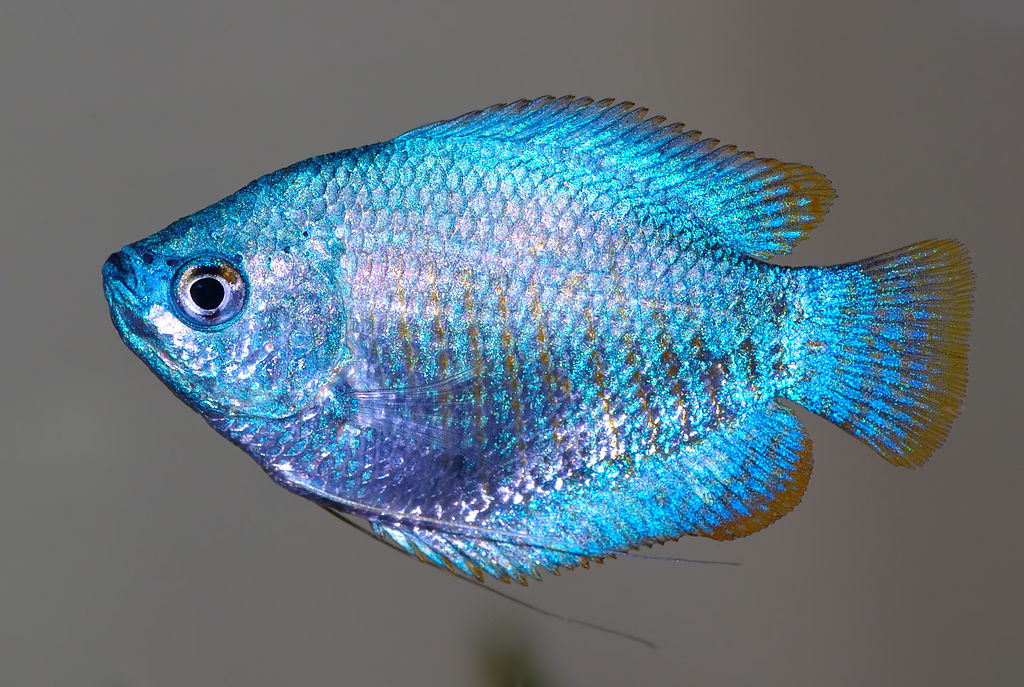
This variant is almost entirely bright blue, giving it a striking appearance that stands out in any aquarium. The Powder Blue Dwarf Gourami is a popular choice for those who want a vibrant, colorful fish.
Flame Red Dwarf Gourami
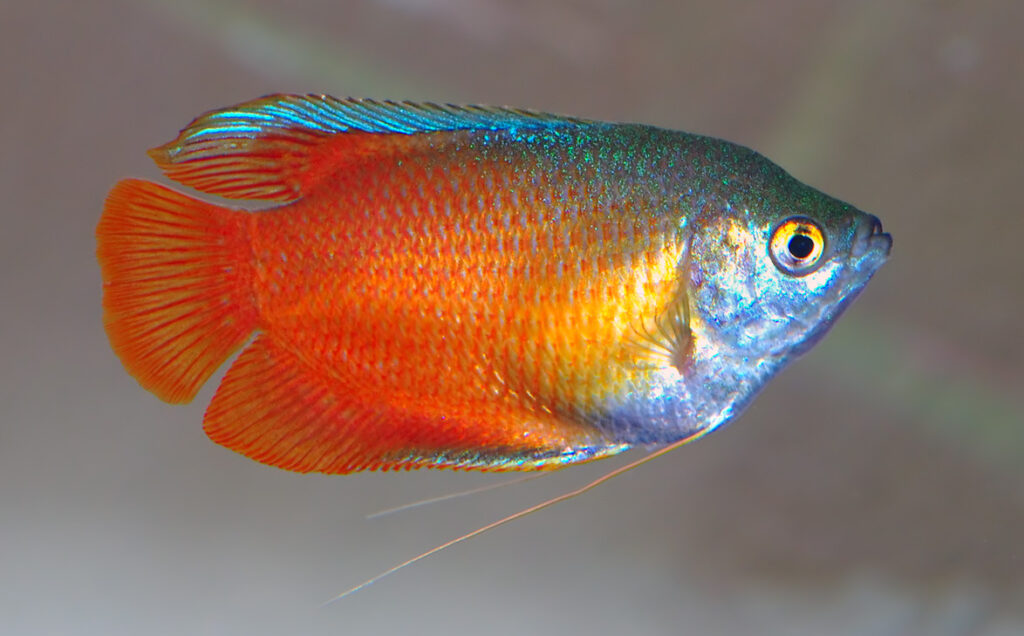
As the name suggests, the Flame Red Dwarf Gourami is predominantly red. This variant is one of the reddest and can sometimes be confused with the red variety of honey gouramis (Trichogaster chuna). The Flame Red Dwarf Gourami adds a splash of fiery color to your tank.
Turquoise/Neon Blue Dwarf Gourami
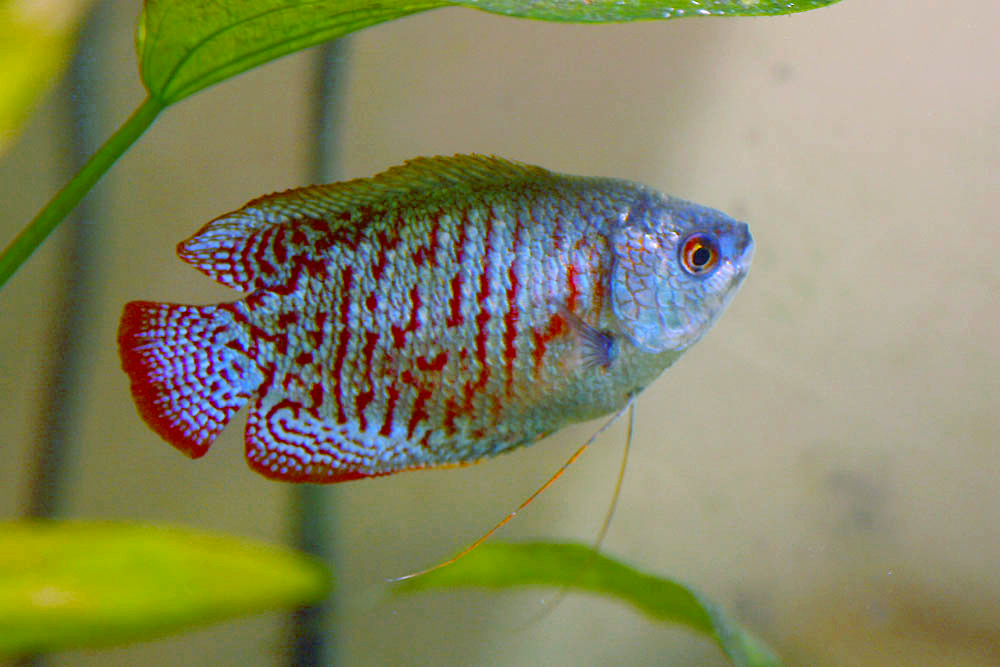
This common color morph features stripes of dark red and bright blue. The contrast between the two colors gives this variant a unique and attractive appearance. The Turquoise/Neon Blue Dwarf Gourami is a great choice for those who want a fish that combines multiple vibrant colors.
Wild-Type Dwarf Gourami
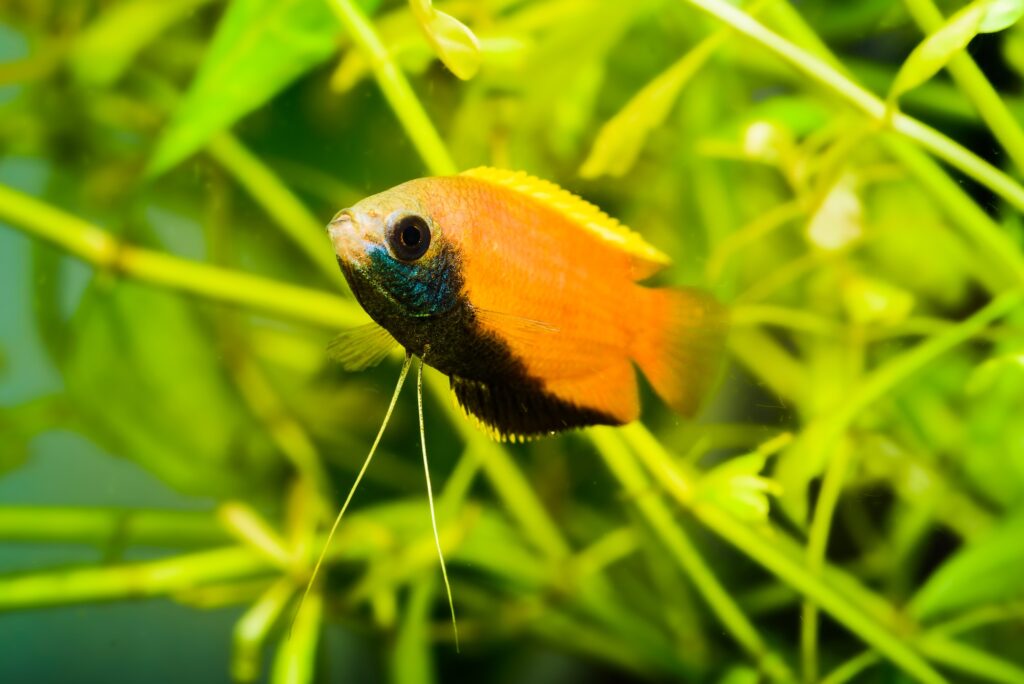
The wild-type Dwarf Gourami displays diagonal stripes of alternating blue and red colors. This is the coloration you would typically see in Dwarf Gouramis in their natural habitat. The wild-type Dwarf Gourami is perfect for those who prefer a more natural look in their aquarium.
Silver Dwarf Gourami
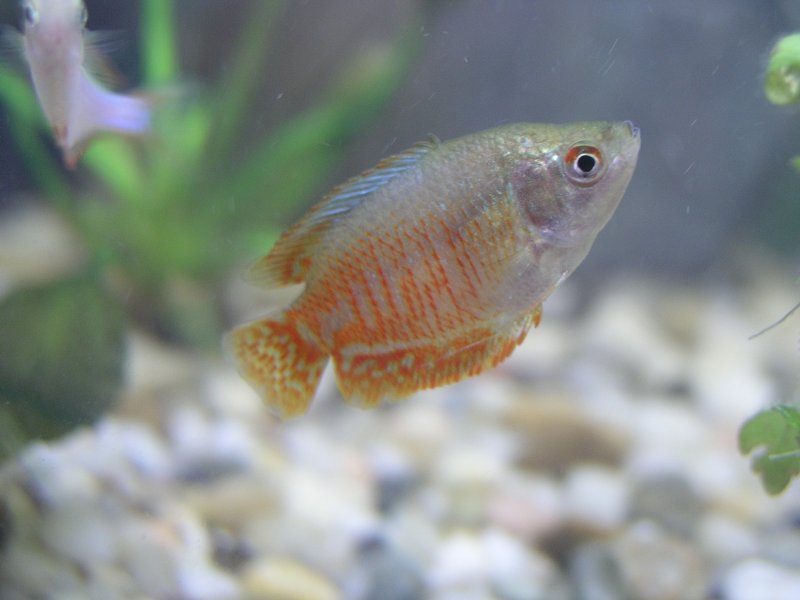
The Silver Dwarf Gourami is typically the coloration of female Dwarf Gouramis. They are a silvery color, which can provide a nice contrast to the more brightly colored males and other colorful fish in your aquarium.
Creating a Comfortable Home: Tank Size and Water Parameters
When it comes to setting up an aquarium for your Dwarf Gourami, there are several key factors to consider. The size of the tank and the water parameters are two of the most important aspects to get right. These elements will significantly impact the health and happiness of your Dwarf Gourami, so it’s crucial to understand them fully.
The tank size for a Dwarf Gourami should be a minimum of 10 gallons. This size provides enough space for your fish to swim and explore, which is essential for their wellbeing. Remember, a larger tank is always better if you have the space, especially if you plan to keep more than one Dwarf Gourami or other fish species.
The water parameters are another crucial aspect of your Dwarf Gourami’s environment. These fish prefer a water temperature between 22–28 °C. Maintaining this temperature range will help ensure your Dwarf Gourami is comfortable and healthy.
In terms of water hardness, Dwarf Gouramis prefer a range of 10–20 dH. They also thrive in a pH range of 6-8. Regular testing of your aquarium water will help you maintain these parameters and quickly address any issues that may arise.
Here are the key points to remember when setting up your Dwarf Gourami’s tank:
- Tank Size: A minimum of 10 gallons is recommended.
- Water Temperature: Maintain a range of 22–28 °C.
- Water Hardness: Aim for a hardness level of 10–20 dH.
- pH: Keep the pH level between 6-8.
Understanding Their Growth: Lifespan and Full Size
When you bring a Dwarf Gourami into your home, you’re making a commitment to care for that fish throughout its life. Knowing how long Dwarf Gouramis live and how big they can grow will help you prepare and take good care of them.
Dwarf Gouramis have a lifespan of 4 to 6 years with proper care. This means that when you choose to add a Dwarf Gourami to your aquarium, you’re making a multi-year commitment to that fish. It’s important to be prepared for this and to ensure that you’re ready to provide consistent care throughout your Dwarf Gourami’s life.
In terms of size, Dwarf Gouramis can reach a length of up to 8.8 centimeters (3.5 inches). This is a relatively small size, making Dwarf Gouramis a good choice for smaller aquariums. However, despite their small size, these fish still need plenty of space to swim and explore, so be sure not to overcrowd your tank.
Here are the key points to remember about the lifespan and size of Dwarf Gouramis:
- Lifespan: Dwarf Gouramis typically live for 4 to 6 years with proper care.
- Full Size: These fish can reach a length of up to 8.8 centimeters (3.5 inches).
Mimicking Their Natural Environment: Behavior, Habitat Preference, and Aquarium Decoration
Creating an environment that closely mimics the Dwarf Gourami’s natural habitat is key to their wellbeing. This involves understanding their behavior, habitat preference, and the type of decorations that would best suit their needs in an aquarium setting.
Dwarf Gouramis are generally known for their peaceful temperament, except for a slight territorial behavior they may exhibit. Despite not being naturally aggressive, these fish do value having their own separate area within the tank. This is something to keep in mind when planning the layout of your aquarium.
Dwarf Gouramis naturally inhabit slow-moving waters in rivulets, streams, and lakes, usually in areas with plentiful vegetation. They prefer environments with plenty of hiding spots and areas to explore. This habitat preference should be reflected in your aquarium setup.
When decorating your aquarium, consider incorporating plants, rocks, and hiding spots. Plants are important for Dwarf Gourami. They give them shelter and keep them safe. They also help keep the water in the aquarium clean and healthy. Rocks and other decorations can provide additional hiding spots and contribute to the overall aesthetic of your tank.
Here are some key points to consider when setting up your Dwarf Gourami’s environment:
- Behavior: Dwarf Gouramis are generally peaceful and slightly territorial.
- Habitat Preference: They prefer slow-moving waters with plentiful vegetation.
- Aquarium Decoration: Incorporate plants, rocks, and hiding spots to mimic their natural environment.
Choosing the Right Company: Tank Mates and Fish to Avoid
One of the most important aspects of keeping a Dwarf Gourami, or any fish for that matter, is choosing the right tank mates. Choosing the right fish for your aquarium is important for the health and happiness of your Dwarf Gourami.
Dwarf Gouramis are generally peaceful fish that do well in community aquariums. They are compatible with most fish that share similar water parameters and are not overly aggressive.
Ideal Tank Mates
- Platies: These are peaceful fish that come in a variety of colors. They are hardy and easy to care for, making them a good choice for beginners.
- Mollies: Mollies are friendly, easy to care for, and come in several color varieties. They are live bearers, which means they give birth to live young.
- Plecostomus: Also known as “Plecos,” these are bottom-dwelling fish that help keep the tank clean by eating algae.
- Ghost Catfish: These are peaceful, schooling fish that are known for their transparent bodies, which gives them their “ghost” name.
- Tetras: Tetras are small, colorful fish that are peaceful and easy to care for. They prefer to be in schools of six or more.
- Corydoras Catfish: These are peaceful bottom dwellers that are great for community tanks. They help keep the tank clean by scavenging for leftover food.
- Guppies: Guppies are small, colorful, and peaceful. They are live bearers and easy to breed.
- Harlequin Rasboras: These are peaceful schooling fish that add a splash of color to any aquarium.
- Zebra Danios: These are hardy and active fish that prefer to be in schools. They are known for their distinctive horizontal stripes.
- Cherry Barbs: These are peaceful fish that add a vibrant red color to your aquarium. They prefer to be in schools.
- Swordtails: Swordtails are peaceful fish known for the long, sword-like extension on their tails. They are live bearers and come in several color varieties.
- Angelfish: Angelfish are peaceful and elegant. They can grow quite large and are known for their long, flowing fins.
- Rainbowfish: These are colorful, active fish that prefer to be in schools. They are peaceful and get along well with other species.
- Loaches: Loaches are bottom dwellers that are known for their unique shape and behavior. They are peaceful and get along well with Dwarf Gouramis.
- Bristlenose Plecos: These are smaller than most Plecos and are known for the bristle-like appendages on their noses. They are peaceful and help keep the tank clean.
- Neon Tetras: These are small, brightly colored fish that prefer to be in schools. They are peaceful and easy to care for.
- Black Skirt Tetras: These are peaceful schooling fish known for their black color and skirt-like fins.
- Gouramis: Other types of Gouramis can also be good tank mates for Dwarf Gouramis, as long as they are not overly aggressive.
- Snails: Snails can be a great addition to a Dwarf Gourami tank. They help keep the tank clean and are peaceful.
- Shrimps: Shrimps like the Cherry Shrimp or Ghost Shrimp can also be good tank mates. They are peaceful, interesting to watch, and help keep the tank clean.
Fish to Avoid
- Bettas (Siamese Fighting Fish): Known for their aggressive and territorial nature, Bettas are not a good match for the peaceful Dwarf Gourami. They may see the Gourami as a threat and can become hostile.
- Cichlids: While there are many species of Cichlids, most are known for their aggressive behavior, especially during breeding. They can bully and stress Dwarf Gouramis, making them unsuitable tank mates.
- Tiger Barbs: Tiger Barbs are known to be fin nippers, which can cause stress and physical harm to Dwarf Gouramis. They are also very active and can overwhelm the more peaceful Gouramis.
- Oscars: Oscars are large, aggressive fish that can easily bully or even eat smaller fish like Dwarf Gouramis. Their size and temperament make them unsuitable tank mates.
- Arowanas: Arowanas are large predatory fish that require a lot of space and can easily eat smaller fish. Their size and predatory nature make them a poor choice for a tank with Dwarf Gouramis.
Feeding Your Dwarf Gourami: Best Foods/Diet
Feeding your Dwarf Gourami the right diet is crucial for their health and wellbeing. As omnivores, Dwarf Gouramis have a diverse diet that includes both plant-based and meaty foods. Providing a balanced diet that meets these needs will help ensure your Dwarf Gourami thrives.
In the wild, Dwarf Gouramis eat a variety of foods, including algae, small invertebrates, and insect larvae. In an aquarium setting, this diverse diet can be replicated by providing a mix of algae-based foods and meaty foods.
Algae-based flake food is a good staple for your Dwarf Gourami’s diet. It provides the plant-based nutrition that Dwarf Gouramis need. In addition to flake food, Dwarf Gouramis also enjoy freeze-dried bloodworms, tubifex, and brine shrimp. These foods provide the protein that Dwarf Gouramis need for growth and energy.
It’s also a good idea to occasionally provide fresh or frozen foods as a treat. This can include vegetables like peas or zucchini, as well as live or frozen brine shrimp or daphnia.
Here are some key points to remember when feeding your Dwarf Gourami:
- Algae-based flake food: This should be a staple of your Dwarf Gourami’s diet.
- Freeze-dried bloodworms: These provide a good source of protein.
- Tubifex: Another good source of protein.
- Brine shrimp: Can be provided live, frozen, or freeze-dried.
- Fresh or frozen vegetables: These can be provided as a treat and offer additional nutrients.
Breeding Your Dwarf Gourami: Tips and Tricks
Breeding Dwarf Gouramis can be a rewarding experience, but it requires some preparation and knowledge. These fish have unique breeding behaviors that you’ll need to accommodate to ensure successful breeding.
One of the most fascinating aspects of Dwarf Gouramis is their reproductive behavior. The male builds a floating bubble nest in which the eggs are laid. Unlike other bubble nest builders, males will incorporate bits of plants, twigs, and other debris, which hold the nest together better.
To encourage breeding, you’ll need to provide the right conditions. This includes reducing the water level during spawning and maintaining a temperature of approximately 28–30 °C. It’s also important to provide plenty of vegetation, as this is essential for nest building.
Once the eggs are laid, the male will protect them and the fry once they hatch. At this point, it’s often a good idea to remove the female from the tank, as the male may become aggressive towards her.
Here are some key points to remember when breeding your Dwarf Gourami:
- Bubble Nest: The male builds a floating bubble nest for the eggs.
- Water Level: The water level should be reduced during spawning.
- Temperature: The temperature should be approximately 28–30 °C during spawning.
- Vegetation: Vegetation is essential for nest building.
- Male Protection: The male protects the eggs and fry, and may become aggressive towards the female after spawning.
FAQs
How can I tell the difference between male and female Dwarf Gouramis?
The sex of these fish can be determined by their dorsal fin: males have a pointed dorsal fin, while females’ are rounded or curved. Additionally, males are usually more brightly colored than females.
What are some common diseases that Dwarf Gouramis can get?
Dwarf Gouramis can be susceptible to a variety of diseases common to freshwater fish, including Ich and Velvet. They can also be affected by Dwarf Gourami Disease, also known as Dwarf Gourami Iridovirus, which is specific to this species. Regular monitoring and maintaining good water quality can help prevent these diseases.
Can Dwarf Gouramis live alone?
Yes, Dwarf Gouramis can live alone. However, they are social fish and often do better when kept in pairs or small groups, provided they have enough space.
Can Dwarf Gouramis jump out of the tank?
Yes, Dwarf Gouramis are known to be jumpers. It’s recommended to have a lid on your aquarium to prevent them from jumping out.
Can Dwarf Gouramis change color?
Yes, Dwarf Gouramis can change color based on their mood, health, or environmental factors. A healthy Dwarf Gourami will have vibrant colors, while a stressed or sick fish may appear pale or have faded colors.
Do Dwarf Gouramis need a heater in their tank?
Yes, Dwarf Gouramis are tropical fish and prefer warmer water temperatures between 22–28 °C. A heater is necessary to maintain these temperatures, especially in cooler climates.
Are Dwarf Gouramis suitable for beginners?
Yes, Dwarf Gouramis are a good choice for beginners. They are hardy, peaceful, and relatively easy to care for, making them a great choice for those new to fish keeping.
How do I know if my Dwarf Gourami is healthy?
A healthy Dwarf Gourami will have vibrant colors, clear eyes, and an active demeanor. They should be eating regularly and not showing signs of stress such as hiding excessively or gasping at the surface.